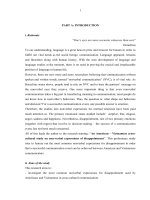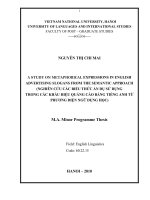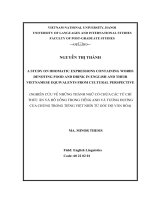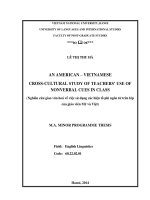An american – vietnamese cross-cultural study on non-verbal expressions of disappointment part 2
Bạn đang xem bản rút gọn của tài liệu. Xem và tải ngay bản đầy đủ của tài liệu tại đây (810.07 KB, 36 trang )
PART A: INTRODUCTION
i. Rationale
“One’s eyes are more accurate witnesses than ears”
Heraclitus
To our understanding, language is a great heaven prize and treasure for human in order to
fulfill our vital needs as the social beings: communication. Language appeared, remains and
flourishes along with human history. With the seen development of language and language
studies at the moment, there is no need in proving the crucial and irreplaceable position of
language in human life.
However, there are now more and more researchers believing that communication without
spoken and written words, termed “nonverbal communication” (NVC), is of vital role. As
Heraclitus states above, people tend to rely on NVC and to base the partners’ message on the
nonverbal cues they receive. One more important thing is that even nonverbal
communication takes a big part in transferring meaning in communication; most people do
not know how to read other’s behaviors. Thus, the question is: what shape our behaviors and
decision? For a successful communication event, one possible answer is emotion.
Therefore, the studies into nonverbal expressions for internal emotions have been paid much
attention to. The primary emotional states studied include: surprise, fear, disgust, anger,
sadness and happiness. Nevertheless, disappointment, one of two primary emotions (together
with regret) that involve in decision-making – the success of a communication event, has not
been much concerned.
All of this leads the author to the research naming: “An American – Vietnamese cross-
cultural study on non-verbal expressions of disappointment”. This preliminary study
tries to feature out the most common nonverbal expressions for disappointment in order that
a successful communication event can be achieved between American and Vietnamese
communicators.
ii. Aims of the study
This research aims to:
- investigate the most common nonverbal expressions for disappointment used by Americans
and Vietnamese in cross-cultural communication.
1
- raise the awareness of the importance of NVC and suggest ways to improve cross-cultural
NVC.
In order to achieve the set aims of the study the research questions are as follows:
- What are the most common nonverbal expressions for disappointment used by Americans
and/or Vietnamese?
- What are the similarities and differences between American and Vietnamese nonverbal
expressions of disappointment?
iii. Scope of the study
Nonverbal messages are widely transferred through many channels. For the common
consideration, it includes: paralanguage, body language, object language and environment
language, of which object language and environment language do not have much
contribution to express emotions which include disappointment. It comes to our awareness
that paralanguage (the vocal characteristics, types of vocal flow, vocal interferences,
silence…) adds a high percentage to the process of communication. However, due to the
time constraint and lack of reliable equipment (voice recorder, voice analyzer…), this kind
of factor will be unavoidably out of the scope of the study.
So, the study only focuses on body language. That is, this study limits itself to facial
expressions, gestures and postures only.
iv. Methods of the study
In order to set up a firm theoretical background for the study, relevant publications are
critically reviewed. Information from the Internet sites and previous studies are also referred
to.
The main method used in this study is quantitative with the illustration of tables and charts
presenting statistic data. The analysis is mainly based on the data collected through the
survey questionnaires.
Consultation with the supervisor, discussion with colleagues, as well as the author’s
observation in daily life and his own experience in cross-cultural communication are also of
great help in finding out the answers to the research questions.
2
v. Organization of the study
The study will be organized into the following structure:
Part A: INTRODUCTION outlines the rationale, the methodology, the aims, the scope, the
significance and the organization of the study.
Part B: DEVELOPMENT
Chapter 1 LITERATURE REVIEW reviews the theoretical issues. It briefly presents and
discusses the theory of communication, NVC with more detailed discussion on facial
expressions, gestures and postures which are major parts of body language. Disappointment
as a human feeling and its nonverbal expressions are also discussed.
Chapter 2 METHODOLOGY describes the data collecting instrument, the informants and
research procedures.
Chapter 3 DATA ANALYSIS AND DISCUSSIONS OF THE FINDINGS presents and
discusses similarities and differences in how to express disappointment nonverbally by the
American and the Vietnamese.
Part C: CONCLUSION
Summary of major findings
Conclusion and Implications for cross-cultural communication
Limitations of the study and Suggestions for further study.
3
PART B: DEVELOPMENT
CHAPTER 1 LITERATURE REVIEW
1.1. CULTURE
As Harrison and Huntington noted, “the term ‘culture,’ of course, has had different meanings
in different disciplines and different contexts”. By stating “culture is the human-made part of
the environment,” W.J.Lonner and R.S.Malpass (1994:7) contrast the culture and the nature.
In their ideas, things in environment will never become cultural without the “touch” of
human.
According to H. Triandis (1994:23), “Culture is a set of human-made objective and
subjective elements that in the past have increased the probability of survival and resulted in
satisfaction for the participants in a ecological niche, and this became shared among those
who could communicate with each other because they had a common language and they
lived in the same time and place.” The subjective elements of culture here are elements such
as values, attitudes, beliefs, orientations and underlying assumptions prevalent among people
in a society. All of these elements act as a framework that influences your interpretation of
the world and interactions in it.
1.2. COMMUNICATION
1.2.1. Definition of Communication
“We are great communicators”
Liz & John Soars: 1997
We, human beings, communicate during our whole life for our own purpose. A child cries
(communicates) to his parents as he needs changing his diaper or feeding. Family members
communicate for help and emotional support and to maintain a good family atmosphere. At
work, people communicate for the purpose of exchanging ideas, negotiating… Leaders
communicate their visions to their staff. Executives communicate to the lower-level
employees. Organizations communicate to their customers and the public. Press conferences,
press releases, employee newsletters, catalogues, direct mail, phone calls, employee
suggestion systems, meetings, formal performance appraisals, on-the-job feedback from
managers, attitude surveys, speeches, conference room briefings, letters, memos and
4
evaluation forms - all of these are examples of communication. We now come to a
conclusion that communication is very important in our lives, as Hybels (1992:5) claims
“Communication, then, is vital to our lives. To live is to communicate.”
Larry A., Richard E. Porter and Edwin R. McDaniel (2006:12) select the all-encompassing
definition of “human communication is the process through which symbols are transmitted
for the purpose of eliciting a response”. Lustig (1996:29) defines communication as “a
symbolic process in which people create shared meanings”. In the both definitions, the
centre is “symbol”. A symbol may be “a word, action or object”, containing thoughts,
perception or feelings one wants to communicate with others.
1.2.2. Forms of Communication
Communication as claimed by Lustig above is the process of exchange shared meanings.
And in order to create share meaning, people have to use code or symbol. In reality, the two
kinds of code or symbol are verbal (spoken and written) and nonverbal (unspoken). These
are referred to as forms of communication.
To get a better view, communication can be illustrated in the following diagram:
1.2.3. Components of Communication
The followings are components of communication according to Hymes: 1972.
- Situation: setting and sense
- Participants: speaker, presenter, hearer, receiver, narrator
- End: purpose, result or goal
- Act sequences: model or language content
- Key: Clues that establish the "tone, manner, or spirit" of the speech act.
- Instrumentalities: channel, form or style
- Norms: norms of interpretation, norms of interaction
- Genres: kind of speech act or event
COMMUNICATION
VERBAL COMMUNICATION NONVERBAL COMMUNICATION
5
Among these, the participants (speaker and hearer) and situation are prominent to the choice
of message coder (language or nonverbal cues used). The participants’ background impacts
much on the choice of the coder used. The background includes: age, sex, living place,
occupation… When discussing different participants and situations, the underlying effect of
power (P), social distance (D) and rank of imposition (R) have to be considered. With
combination of the three factors, the choice of message coder can be in diversity.
1.2.4. Cross-cultural communication
The relationship between culture and communication is often compared with the bond
between the voice and the echo. From culture and communication, there are three branches
of communication as follows:
Intra-cultural communication: is the communication between people who live in the same
country and come from the same cultural background.
Inter-cultural communication: is the communication between people who live in the same
country but come from different cultural background.
Cross-cultural communication: is the communication between people who live in different
countries and come from different cultural background.
Coming from different geographic locations and holding different values, beliefs,… people
in cross-cultural communication face more problems than in intra-cultural and inter-cultural
branches. This is because people have different ways of interpreting social meanings
conveyed in their interaction with the outside world.
1.3. NONVERBAL COMMUNICATION
1.3.1 Definition of nonverbal communication
In the process of communication, people do not only send verbal messages but nonverbal
ones as well. NVC is understood as a way of communicating without the use of written or
spoken language.
According to Lustig (1996:187-188), “nonverbal communication is a multi-channeled
process that is usually performed simultaneously; it typically involves a subtle set of
nonlinguistic behaviors that are often enacted subconsciously. Nonverbal behaviors can
become part of the communication process when someone intentionally tries to convey a
6
message or when someone attributes meaning to the nonverbal behavior of another, whether
or not the person intend to communicate a particular meaning.” As Lustig pointed out, when
some meaning is attached to a nonlinguistic behavior, whether by message transmitter or
perceiver, that behavior becomes part of communication process.
The detailed description of NVC is presented by Nguyen Quang “all the components of the
message that, when taken together, constitute the communication which is not verbally
coded but both vocally and non-vocally channeled. Nonverbal communication is composed
of paralinguistic factors (nonverbal - vocal channel), such as rate, volume, etc., and extra-
linguistic factors (nonverbal - non-vocal channel), such as body language (gestures,
postures, facial expressions,…) object language (including clothing, jewelry…) and
environmental language (proxemics, settings…)”.
1.3.2 Importance of nonverbal communication
Most people believe the best way of communicating is verbal. However, NVC is there, even
when people do not speak a word. Pease (1984:7) states “The miracle is that human hardly
recognize his or her appearance, movements and gestures can tell one story while his or her
voice is telling another story.” (Cited in Nguyen Quang).
A number of researches, with different approach and methods have pointed out the
importance of NVC.
Albert Mehrabian found that the total impact of a message is about 7 percent verbal (words
only), 38 percent vocal (including tone of voice, inflection and other sounds) and 55 percent
nonverbal. (Pease, 1984:6)
Importance of nonverbal
communication - Mehrabian
7%
93%
Verbal
Nonverbal
Chart 1: Importance of Nonverbal Communication
It is easy to conclude that NVC is an indispensable and all pervasive element in human
7
behavior. Perhaps its most obvious application is found in the fact that young children start
comprehending words at around six months of age yet understand NVC well before that
time. Hence, from the moment of birth to the end of life, NVC is an important symbol
system.
1.3.3. Differences between Nonverbal Communication and Verbal Communication
First of all, NVC seems to be more ambiguous than verbal communication. This is because
nonverbal cues can be intentional or unintentional. If an intentional behavior is perceived
and interpreted correctly, this can help to maintain good communication. Meanwhile, if an
unintentional behavior is interpreted as conveying meaning, it can cause the social
interaction to go wrongly or even stop. Additionally, the nonverbal cues can carry various
meanings. A silence can be interpreted as: agreement, disagreement, wondering, waiting for
other’s response, an indicator of surprise or happiness…
Secondly, NVC is continuous. Verbal communication only starts when people start to make
sounds in an organized order and stops when the sound chunks stop. However, NVC starts
when someone appears in communicating partner’s sight, continues even when the two
people keep silent, and only ends when one gets out of the other’s sight.
Thirdly, NVC is multi-channeled. Units of verbal communication appear in a linear order in
accordance with rules of grammar, vocabulary…. Nonverbal cues appear at the same time,
requesting us to receive by some, even all five of our senses. There are not only cues but also
cluster of cues and areas of cues.
Fourthly, NVC reveals more about human’s emotion than verbal communication. Verbal
communication is often thought to be accurate in describing the various emotional states. In
fact, it only describes either one aspect or one status of that emotional state.
The fifth characteristic of NVC is that people tend to rely on NVC if there is contradiction
between verbal messages and nonverbal messages.
Last but not least, nonverbal cues can be perceived and interpreted differently in different
societies. The same meanings can be expressed by different nonverbal cues and the same
cues can be interpreted as conveying different meanings in different cultures.
1.3.4 Classification of nonverbal communication
Dwyer (2000) classifies NVC into: body movement, physical characteristics, touch, vocal
8
characteristics (paralanguage), space (proximity), artifacts, and environment.
Hybels categorizes NVC into paralanguage, body movement/ kinesics, proxemics,
chronemics, aesthetics, physical characteristics and artifacts.
Lustig et. al. discusses six types of nonverbal codes including: body movement/ kinesics,
touch, time/ chronemics, voice, and other nonverbal code systems, consisting of chemical,
physical, dermal and artifactual systems.
Of the various classifications, Nguyen Quang (2001:9) presents a detailed and easy-to-follow
one in the diagram below.
Diagram 1: Classification of Nonverbal Communication
1.3.5. Nonverbal communication across culture
As shown in the discussion of differences between NVC and verbal communication,
Nonverbal Communication
Paralanguage Extralanguage
- Vocal
characteristics
+ Pitch
+ Volume
+ Rate
+ Vocal quality
- Types of vocal
flow
- Vocal
interferences
- Silence…
Body language/
Kinesics
Object language/
Artifacts
Environmental
language
- Eye contact
- Facial
expressions
- Physical
characteristics
- Gestures
- Postures
- Body
movements
- Touch/ Haptics/
Tactile
…
- Clothing
- Jewelry
- Accessories
- Make-up
- Artifactual
scents
- Gifts
- Flowers
…
- Setting
- Conversational
distance/
Proxemics
- Time/
Chronemics
- Lighting
system
- Color
- Heat
…
9
nonverbal cues can be ambiguous even with people of the same culture. With people from
different cultures, this is obviously more problematic.
A big amount of nonverbal cues are culture-specific. This means these cues convey the
messages that only members of that culture can interpret correctly.
1.4. DISAPPOINTMENT AND ITS NONVERBAL EXPRESSIONS
The size of your success is measured by the strength on your desire, the size of your dream,
and how you handle disappointment along the way
Robert Kiyosaki
Is there any one here who has not experienced disappointment in his or her life? It is one of
the oldest human experiences. Each of us could make a lot of our unfulfilled wishes or seeds
we planted which never grew into plants. Anyone who has hopes or dreams may be waited
by some disappointment. When their hopes or dreams can not become true. Alexander Pope
wrote “Blessed is the man who expects nothing, for he shall never be disappointed”.
Disappointment is a problem which transcends economics. We can be well-off financially
and still have all kinds of disappointment. We can be disappointed with our family members,
disappointed with our friends, with our marriage, or jobs for not reaching whatever goals we
have set for ourselves. We can be disappointed because our life lacks meaning and direction.
Let us consider a situation described by David E. B. (Jan-Feb. 1985): your boss tells you he
is delighted with your performance over the past year and is giving you a $5000 bonus. Are
you pleased? If you were not expecting a bonus, you would be delighted. If you were
expecting a $10,000 bonus, you would be disappointed. He (David E. Bell) claims that
“Disappointment is, then, a psychological reaction to an outcome that does not match up to
expectations”.
In a broader view, Loralea Michaelis states “Disappointment is a characteristic feature of
our shared condition as mortal creatures subject to the experiences of failure and
frustration: our plans may go awry, our actions may have unwanted consequences, our
expectations may be frustrated and, in a more general sense, we are rarely the kind of
people we would like to be.”
It is stated in a sermon in St. Ansgar’s Lutheran Church that “in the simplest terms,
disappointment is unmet positive expectation. The word positive here is important. There
are some unmet expectation which bring us joy and satisfaction and not disappointment. For
10
example you might go to see a physician with the expectation that your symptoms will lead
to a diagnosis of terminal cancer. You will not be disappointed if that expectation proves to
be false. Disappointment occurs when we expect a certain good thing to take place and it
doesn’t.”
The same idea can be seen from Levering Bas “The question is whether expectation is a
sufficient condition for disappointment. Do unfulfilled expectations by definition lead to
disappointment? When a negative expectation is nourished, that is, when I expect something
I would rather not see happen, and in fact it does not happen, then I feel relief instead of
disappointment. The question is whether relief can been seen as the opposite of
disappointment in the sense that the former is about a cheerful feeling and the latter about
an unpleasant one. If I pass an exam about which I have had the most anxious expectations.
I am first relieved, then glad. This means that when talking about disappointment, there are
always desired expectations involved.”
According to Moyo-Angle Bamidele, “everyone that has expectations and desires in life will
experience disappointment in one way or the other” and we experience disappointment
when:
- When we expect something to happen soon but it does not
- When input is not equal to output
- When things does not work out as plan
- When we believe too much in people
- When we expect things to happen in our own ways but they do not.
According to David. E. Bell (Jan.1985), disappointment is similar to regret:
“Disappointment is the feeling of dissatisfaction that follows the failure of expectations to
manifest. Similar to regret, it differs in that the individual feeling regret focuses primarily on
personal choices contributing to a poor outcome, while the individual feeling
disappointment focuses on outcome.”
Francesco Marcatto and Donatella Ferrante claim that regret and disappointment are
different emotions. They are both generated by comparing “What is” with “What might have
been”. However, “the emotion of regret results from a comparison between an actual
outcome and a better outcome that might have occurred had another option been chosen
(choice- or –behavior-focused counterfactual). Conversely, disappointment stems from the
comparison of an actual outcome with a better outcome that might have resulted had world
11
events occurred differently (situation-focused counterfactuals) (van Djik, van der Pligt &
Zeelenberg, 1999)”
Disappointment may be very short-lasting and easy to transfer to another emotional state,
anger, frustration or the like. This emotional state can also be very harmful because it may
lead to the following in communication:
- Lack of trust.
- Destruction of relationship
- Changing our perceptions to life, people and things we do.
According to many researchers and the author’s personal observation, expressions of
disappointment is highly-culture-controlled. In most Oriental countries, people, especially
women, are taught not to express their emotional states, especially ones like disappointment,
in social interaction in order to maintain the harmony in the community. However, at many
points during the communication process, disappointment is intentionally expressed, not
verbally but non-verbally, in order to let the partners to know our own emotional state.
From the author’s own observation and analysis of videos and photos searched on the
Internet, the most popular expressions for disappointment are as follows:
Facial expressions:
When disappointed, people seem to have abnormal head positions which include: side-tilted
(left or right side), head-down (tilted forward) or face-up (to the ceiling). The side-tilted
position can be found mostly when people are sitting while head-down and face-up is often
found with standing postures.
The eyes of disappointed people tend to lower down or to aim at nothing. Many cases are
found with frowning eyes – eyebrows are pushed together. Another popular cue is the curve-
up of eyebrows with frowning forehead. In addition, the disappointed gaze is not very often
straight. It is often down-looking with lowered eyelids, sometimes up-looking or side-
looking, especially, when people try to control the disappointment, they tend to move eye
sight from side to side, avoiding eye contact with communicating partners.
With mouth, there are some popular cues including: contorted (pushed to one side), pouting
(upper and/or lower lip pushed up). Sometimes, the stiff lips are also found with hard-
pressed lips and jaws making lips thinner than in normal state. There are still cases in which
people have smirks – or contorted smiles.
For gestures, it is the most common to find hand-with-face gestures and hand-with-head
12
gestures. They can be: one palm covering one eye and/or cheek, one palm covering forehead,
both hands covering face, one or both hands touching or pulling hair. With sitting postures,
fisted hand or hands, open palm or palms pushing cheeks or supporting chin can be found.
Another popular cue is the wide open arms with shrugging shoulders. With standing posture,
the cue of arms over head (like religious gesture of Muslim people when praying to Allah) is
also found. Besides, the followings are also met: thumb-down gesture together with spouting
lips, head shaking from side to side while spouting lips and maintaining lower look.
Disappointed postures vary into categories: sitting and standing. For sitting postures, the
followings can be found: collapsed posture with slouching arms and head down, head resting
on folded arms, whole body collapsed with chin resting on table, semi-lying posture (like
ownership posture with feet on floor) and knees up head down. For standing and walking
postures, the most common are collapsed standing posture with head down or face up, with
slouching arms or hands resting on hips. The following shift-of-postures are regularly met:
from normal posture, especially sitting one, shifting to a collapsed one with back resting;
from standing posture shifting to a sitting or lying one. When people are trying to put their
disappointment under control, they can shift the head from the normal state into a face-up
(often found with middle open mouth), maintain some seconds and then back to the normal
state.
Followings are some illustrations of nonverbal expressions of disappointment.
Head position: The head in this expression is little tilted to the left or
right
Facial cues: The lower eyelids are a bit pulled down and the eye gaze
fixes at a low or sided position. Lips do not close completely and lip
corners are a little pulled down.
Posture: Standing or sitting posture, arms are folded in a standard
arm-cross
Head position: The head is often side-tilted.
Facial cues: Both lower and upper eyelids fall down making the eye
gaze a little down. The lower lip is a bit pulled down and the mouth
does not completely close.
Gesture: The arms are straight down along the body in standing
posture or put on thighs in sitting one.
13
Head position: The head is often in straight position.
Facial cues: Both upper and lower eyelids fall down while inner
corners of eyebrows are raised making a frowning forehead. The eye
gaze is often a little down The lips are in normal state
Gesture: Both hands are straight, holding cheeks
Head position: The head is often bent forward and/or little tilted.
Facial cues: The lower eyelids are pulled down with eyebrows
curving up making the forehead frowning. The eye gaze is often fixed
at a low position.
Gesture: One hand supports the chin and covers the mouth with
fingers close.
Posture: This is a sitting posture with bending-down back, one elbow
putting on the thighs.
Facial cues: Both upper and lower eyelids are pulled down with
eyebrows being pushed together. The eye gaze is fixed on the floor or
a very low position. The lower lip is a bit pushed up making the area
between lower lip and chin like a hollow.
Head position: The head is straight or little forward-leaning.
Facial cues: This face seems to have nothing “abnormal” except a
little frown on the forehead made by the little raise and drawing-
together of the inner corners of eyebrows. The eyes are expressive
with low eye gaze which does not focus. Lips, chin and nose are in
neutral states.
Head position: The head is often straight or little tilted.
Facial cues: Both upper and lower eyelids are pulled down while the
inner corners of eyebrows are raised, making the curving lines on the
forehead. The lower lip is raised whereas the lips corners are pulled
down shaping the mouth into a reversed “u”. The muscles below lip
corners are pulled down while the area between lower lip and chin is
pulled up.
14








